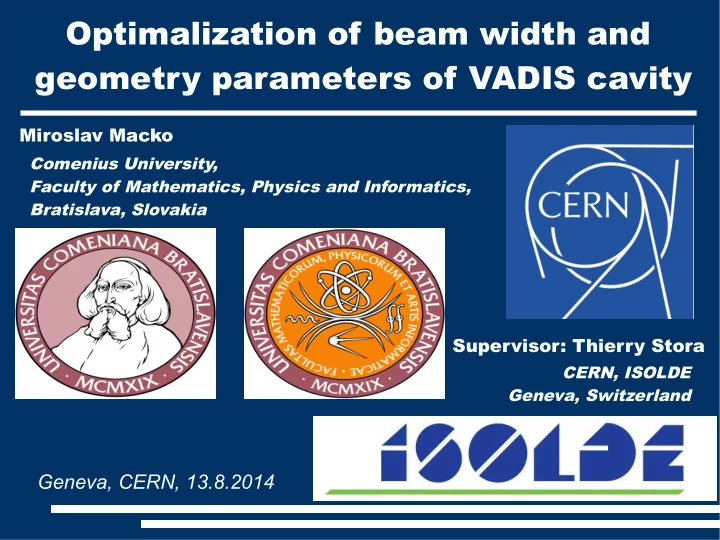

Optimalization of beam width and geometry parameters of VADIS cavity Miroslav Macko Comenius University, Faculty of Mathematics, Physics and Informatics, Bratislava, Slovakia Supervisor: Thierry Stora CERN, ISOLDE Geneva, Switzerland Geneva, CERN, 13.8.2014
Contents ● What is VADIS? ● The problem ● Explanation ● CPO model ● Original approach ● Our model ● Results and conclusions ● Future work Geneva, CERN, 13.8.2014
What is VADIS? ● Versatile Arc Discharge Ion Source ● Cavity ● Cylindrical symmetry ● Difference in aperture MK7 VADIS MK7 VADIS Source: [1] Liviu Constantin Penescu Geneva, CERN, 13.8.2014
How it works? ● Anode at 150 V ● e - accelerated to 150 eV by grid ● Ions created in collisions with neutral atoms ● Positive ions extracted in aperture MK7 VADIS Geneva, CERN, 13.8.2014 Source: [1] Liviu Constantin Penescu
The problem Source: [1] Liviu Constantin Penescu Geneva, CERN, 13.8.2014
Explanation ● Ions extracted at temperature ~ 2000°C ● Kinetic energy: 2000°C ~ 0,2 eV ● Borders of active volume – 149,8 V potential line because 150V-0,2V=149,8V Source: [1] Liviu Constantin Penescu Geneva, CERN, 13.8.2014
CPO model ● Potential line penetration (MK7) Geneva, CERN, 13.8.2014
CPO model ● Potential line penetration (VADIS) Geneva, CERN, 13.8.2014
CPO model MK7 VADIS Geneva, CERN, 13.8.2014
Original approach ● Ions and electrons -> space charge in cavity ● Two calculations ● a) Electrons (ions negligible) ● b) Ions (electrons negligible) ● Result = superposition of two fields Geneva, CERN, 13.8.2014
Original approach (example) Electrons Ions Geneva, CERN, 13.8.2014 Source: [1] Liviu Constantin Penescu
Original approach (results) Source: [1] Liviu Constantin Penescu Geneva, CERN, 13.8.2014
Our idea ● Is previous approach the best possible? ● What about interaction between electrons and ions? ● Electrons „set“ potential for ions ● Before including ions it may be useful to study how electrons act under different conditions ● After that sending ions into „specificaly tailored“ potential of electrons (future work) Geneva, CERN, 13.8.2014
Our model ● How to calculate potential assuming space charge of electrons? Geneva, CERN, 13.8.2014
Our model ● What is typical shape of such potential? Geneva, CERN, 13.8.2014
Our model ● What is typical shape of such potential? Geneva, CERN, 13.8.2014
Our model ● How can we influence these parameters? Geneva, CERN, 13.8.2014
Our model ● How can we influence these parameters? ● Possible tools ● a) „Better aiming“ ● b) Change of current density ● a) Better aiming by change of beam radius ● b) Current density by change of cathode temperature Richardson´s law: J=AT 2 exp(-W/kT) Geneva, CERN, 13.8.2014
Our model ● Definition of beam radius „r“ Geneva, CERN, 13.8.2014
Simulated data (MK7) Geneva, CERN, 13.8.2014
Simulated data (VADIS) Geneva, CERN, 13.8.2014
Potential minimum MK7 VADIS Geneva, CERN, 13.8.2014
Neck value MK7 VADIS Geneva, CERN, 13.8.2014
MK7 vs. VADIS Potential minimum Neck value Geneva, CERN, 13.8.2014
Infinite charged cylinder? Geneva, CERN, 13.8.2014
Quo vadis VADIS? ● Can we reproduce potential shape on axis by summation of potentials of infinitezimaly thin discs? Q(z) z dq1 dq2 dq3 dq4 dq5 Geneva, CERN, 13.8.2014
Quo vadis VADIS? ● Is shape in radial direction really charged cylinder potential? ● Poisson equation in cylindrical coordinates ● How much ions „ruin“ these models? ● What measurable variables we can obtain? ● Are these consistent with experiment? ● What is the influence of changed geometry? Geneva, CERN, 13.8.2014
Aknowledgments: ● I would like to thank Thierry Stora for his advices and for all support and help I needed. My thanks to all of you! Thanks to you I spent really nice two months here! Thanks for this experience! References: ● [1] Liviu Constantin Penescu, Techniques to produce and accelerate radioactive ion beams , Bucharest, 2009 ● [2] FH Read and NJ Bowring, The CPO programs and the BEM for charged particle optics , Nucl. Instr. Meth. A645, 273-277 (2011) Geneva, CERN, 13.8.2014
Recommend
More recommend